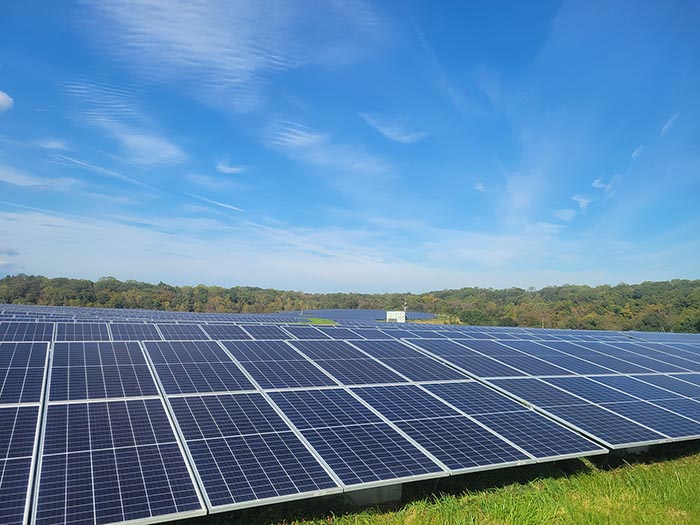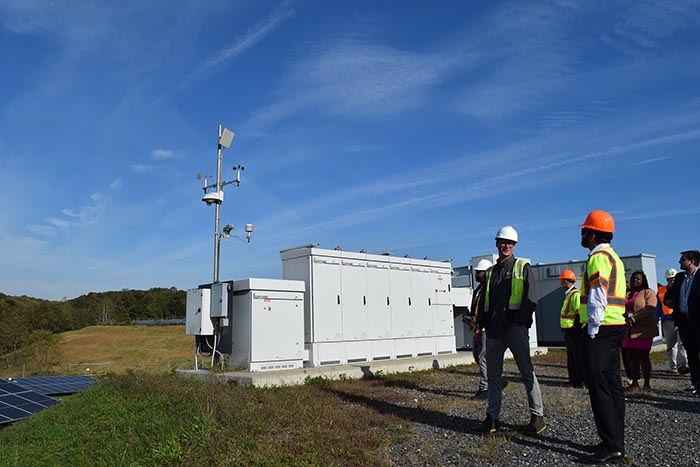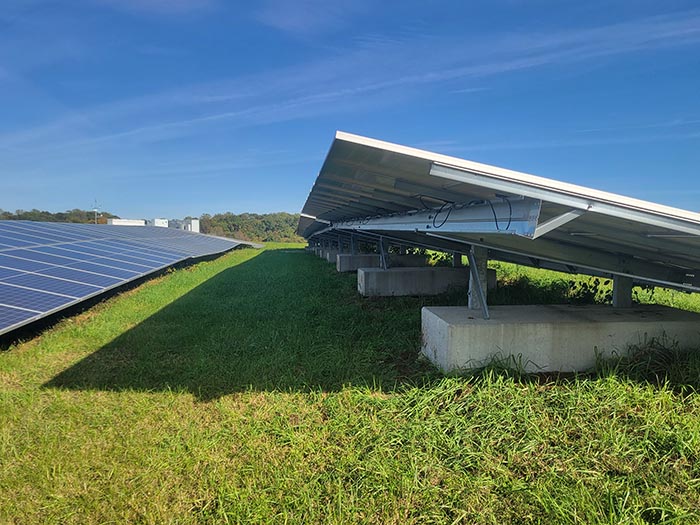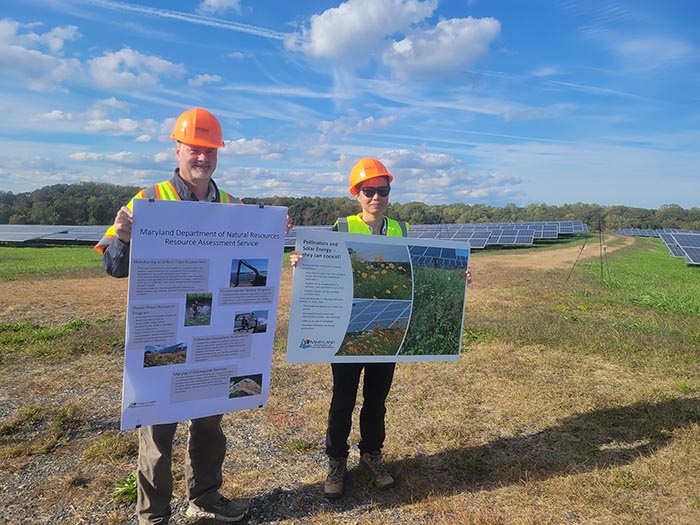DNR points to project as example for renewable projects in the state

Arrays of solar panels capture up to 12 megawatts of electricity at the Annapolis site. Photo by Joe Zimmermann.
Off Route 450, just outside of Annapolis, there’s an unassuming side road that cuts through a forest.
For almost 40 years, city trash trucks hauled up and down the winding road to a landfill on top of the hill. Then, in 1989, the landfill reached its capacity and was covered, and the site sat quietly for nearly three decades, hidden away behind a stretch of trees.
But now, the hill has a new purpose. Sitting atop the buried landfill are 55,000 solar panels, making up a solar site with an output capacity of 12 megawatts.
“The City of Annapolis was a leader in converting a vast urban brownfield into a place where clean, renewable energy is produced to serve the energy needs of the city and Anne Arundel County,” Jacqueline Guild, Annapolis Deputy City Manager for Resilience and Sustainability, said at a DNR Science Week event in October that toured the facility. “We took a contaminated site and turned it into an asset that is generating revenue, providing inexpensive power, and reducing local greenhouse gas emissions.”
While the landfill makes the area unsuitable for other types of development, the site proved ideal for solar energy because it has a high elevation and no tree cover, Guild said. It’s also an unobtrusive presence, as it’s only visible to a few nearby residents during the winter, she said.

DNR Secretary Josh Kurtz inspects a solar inverter, which converts the output of solar panels into alternating current. Photo by Joe Zimmermann

The solar panels sit on concrete slabs that protect the geomembrane covering the buried landfill. Photo by Joe Zimmermann
The site opened in June 2018 as a partnership between the City of Annapolis and the energy company Building Energy, with support of the Maryland Department of Natural Resources. Building Energy has since been acquired by Novis Renewable Holdings, which operates the site. The solar arrays now provide energy to Annapolis, Anne Arundel County, and the Anne Arundel County Board of Education.
Thomas Leahy, president of Novis Renewable Holdings, suggested that the site—a repurposed landfill that now generates clean energy and has a positive impact on the environment—is an example of what can be achieved with innovative thinking.
“With sustainability at the core of our activities, it’s a privilege to be part of this project which has transformed an unused and seemingly unusable piece of land into something that we can all be proud of,” Leahy said.
DNR and Annapolis officials point to the project as a model for renewable energy sites in the state.
DNR’s Power Plant Research Program Director Bob Sadzinski said solar projects are critical to meet the state’s renewable energy goals.
“Gov. Moore has positioned Maryland as a leader in green energy with some of the most aggressive renewable energy goals in the nation,” Sadzinski said. “By 2030, Maryland is planning for 50% of our energy to come from renewables, of which 14.5% is expected to come from solar.”
The Power Plant Research Program (PPRP) conducts consolidated environmental reviews of all issues related to power generation and transmission in the state. PPRP aims to allow Maryland to meet electricity demands at a reasonable cost while also considering a variety of environmental and socioeconomic factors, from protecting natural resources and historical sites to promoting environmental justice and job creation.
The Maryland Public Service Commission has granted certificates to proceed for 54 utility-scale solar projects, with eight more projects in progress. Of those approved, 37 are now operational.
Across the state, solar power has a capacity of 1,950 megawatts of electricity, or about 4.3 million megawatt hours of energy annually, with another 882 megawatts projected from new sites that will be built in the next three years, Sadzinski said. That would be enough to power about 429,000 homes every year.
To help developers and officials identify potential locations for future solar and wind projects, PPRP has sponsored an interactive map-based screening tool called SmartDG+, which identifies areas based on proximity to electrical lines, land cover, zoning. and other factors.
PPRP also oversees a program that grants a pollinator-friendly designation to solar facilities. With the decline in bees and other pollinator species in recent decades, solar arrays have been identified as beneficial habitats for pollinators. The program encourages solar sites to use a seed mix of native Maryland wildflowers that can be planted in the open space around arrays. Once the flowers become established, they will attract pollinators.

DNR staff share details on power plants in the state and the PPRP’s pollinator program. Photo by Joe Zimmermann
Annapolis officials are hoping to make the former landfill site friendly to pollinators. Guild said the city is also considering adding signage to a trail that adjoins the site to inform residents about the solar panels.
DNR Secretary Josh Kurtz, who joined in the tour of the site during DNR’s Science Week, said he was glad to see a successful solar site on the land and hopes to see more built on brownfield sites.
“We’re really excited to hear more about what’s being done here,” Kurtz said. “We’ve got several brownfields in the state, and they provide an excellent opportunity for development for renewable energy.”

Secretary Kurtz and Jacqueline Guild, Annapolis Deputy City Manager for Resilience and Sustainability, tour the site with other officials. Photo by Joe Zimmermann
By Joe Zimmermann, science writer with the Maryland Department of Natural Resources.
